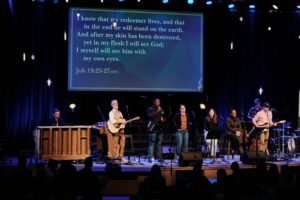
NASHVILLE, Tenn. (BP)–The man most often identified as architect of the conservative movement in the Southern Baptist Convention offers his personal observation of those events and the reason for his front-line involvement in a new book, “A Hill on Which to Die: One Southern Baptist’s Journey.”
The account by Paul Pressler of Houston is the first insider’s look at the controversy from a conservative’s perspective, following a string of books by moderate authors published earlier in the decade.
It is the retired appellate court judge whom many church historians, sociologists and former SBC leaders cite for figuring out the mechanics required to effect leadership changes that could cause a theological shift in the convention.
“Paul Pressler put two and two together,” writes sociology professor Nancy Ammerman in her book, “Baptist Battles.” “He figured out that the denomination’s machinery could be wrested from the hands of its progressive (he would say liberal) bureaucratic leaders. His discovery changed the course of this fundamentalist movement and focused its energies inside the denomination.”
Pressler writes in his book he never sought such notoriety and viewed his initial involvement as short-term. “I thought that once we raised questions about the theological problems in our institutions, those in positions of authority would be willing to listen, others would lead and the issues would be solved.”
Such was not the case, he writes, detailing the “rebuff” he and others received from denominational employees. “I was not prepared for the onslaught directed against us by those vested with power within the convention.”
Pressler writes that his motivation for writing the 240-page book being released in June by Broadman & Holman Publishers of LifeWay Christian Resources is based on his expectation that history might not deal charitably with the conservative movement because existing accounts have been written by persons on the other side.
“I know now, more than ever, that I see events and people through the opinions and prejudices of those who are writing about them,” Pressler writes.
He is hopeful that those who study the SBC might know “what was really in the heart and mind of one of the participants” by reading his book. “This is not an argument for victory, but an explanation of why a course correction had to occur and why, at great sacrifice, the battle had to be waged.”
As the most visible leader of that battle, Pressler has been identified by church historian Bill Leonard of Wake Forest University as an “agenda fundamentalist” and by Walter B. Shurden of Mercer University as a “political strategist.”
Pressler writes that he and other conservatives were willing to make personal sacrifices, believing that “many people who could have been won to Jesus Christ would be eternally lost if liberal theology destroyed the Southern Baptist Convention as a force for evangelism and missions.”
During the two previous decades, Pressler recounts, conservatives were accused by some denominational leaders of being ignorant of Southern Baptist polity and heritage. Pressler quotes a 1979 confrontation he had with Russell Dilday, then-pastor of Second Ponce de Leon Baptist Church and later president of Southwestern Baptist Theological Seminary. Dilday accused him of doing “a horrible thing in stirring people up,” Pressler writes, recounting that he felt treated as an outsider who was “treading on the private domain of someone who was fully in charge, and they deeply resented any intrusion.”
Pressler devotes several chapters of his book to his ancestors who served as role models for him as an active layman in Baptist life, noting that his own Baptist bloodline predates the founding of the Southern Baptist Convention. He explains how challenges he received to his own faith while a student at Princeton — and in visits to nearby higher education institutions Smith, Harvard, Yale and Exeter — provided fodder for his passionate opposition to liberal influences exercised by professors over immature students.
It was the 1961 release by Broadman Press of “The Message of Genesis” by Ralph Elliott that prompted him to consider the danger of theological drift in his own denomination, Pressler writes. He found the commentary by Elliott, then a professor at Midwestern Baptist Theological Seminary, comparable to the liberal theology he had heard at schools in the Northeast.
Pressler was surprised to find support for Elliott at his own Second Baptist Church in Houston and encouraged fellow member and businessman John Baugh’s call for a committee to study allegations of liberalism. While the committee ultimately supported the work of SBC seminaries against attacks on professors like Elliott, it was Pressler’s lengthy minority report that he believes caused him to be removed from a leadership role in the church.
That was the beginning of many broken relationships, Pressler writes. Later, Baugh would take a prominent role in supporting moderate organizations that opposed Pressler and fellow conservatives.
Pressler’s concern over the Elliott controversy provided an introduction to Paige Patterson, then a student at New Orleans Baptist Theological Seminary. Pressler describes their lengthy visit at the French Quarter’s Cafe du Monde in March 1967 as “a time for ones who had experienced liberalism in the Southern Baptist Convention to share their mutual concerns about the effect this was having on the proclamation of the gospel.”
Over the next decade, both Pressler and Patterson would take their message on the road, speaking to groups of all sizes about their growing concerns. Their three-point message dealt with the problem, the existence of a method for correction and the need to motivate people to attend annual meetings of the SBC.
Their efforts in raising concerns led to the election of a conservative candidate in 1979. Pressler recounts the events surrounding the election of the subsequent presidents through 1998 when Patterson, then president of Southeastern Baptist Theological Seminary, was elected by acclamation.
Rather than giving a chronological history, Pressler analyzes the influence of various groups, including the secular and denominational media, over the course of the controversy. He describes the media’s role as “mostly negative,” accusing some editors of laziness that caused repeated fictitious accounts to “become reality in the press.”
While Pressler was dealing with the public notoriety of his battle for the SBC, he was facing a personal crisis over the sudden onset of seizures and severe headaches experienced by his teenage son, Paul IV. First diagnosed as a form of multiple sclerosis, doctors have since determined that the Presslers’ son is highly allergic to mercury and other heavy metals. Though disabled, he graduated from high school and completed college courses at Houston Baptist University.
“Many people who have criticized me because of my SBC involvement do not know the personal strain under which I have operated,” Pressler writes. As he watched the deliberations of the 1979 Houston convention from a friend’s skybox, he listened to his son crying from his severe headaches. “Anybody who thinks that I could have had the composure to direct what was happening on the floor of the meeting — as some have charged — simply does not know the situation.”
Those now-famous skyboxes are explained in Pressler’s book, along with many events he believes were exaggerated or misrepresented, distracting observers from his message. He responds to allegations of voting irregularities, busing of conservative messengers, positioning of candidates, illegal messengers and the existence of a 10-year plan for controlling the boards of the SBC, providing clarifying information.
Pressler also describes conversations and correspondence with well-known Southern Baptist pastors such as W.A. Criswell of Dallas, W.O. Vaught of Little Rock, Ark., and Herschel Hobbs of Oklahoma City. Private disagreements with seminary presidents Randall Lolley of Southeastern, Russell Dilday of Southwestern and Duke McCall of Southern are included. Behind-the-scenes deliberations by Pressler and other members of the SBC Executive Committee are described as an effort to shift decision-making from paid denominational employees to trustee bodies.
A chapter titled “Bits and Pieces” is offered as a “potpourri of vignettes” to fill in information gaps for those studying the conservative resurgence. Another section features Pressler’s “heroes of the resurgence” as he describes the critical role played by various conservatives.
In his projection for the future of the denomination, Pressler warns against:
— a bureaucracy that becomes “an end to itself and not a means to effectuate the principles for which it was founded.”
— developing a “good-ol’-boy” system comparable to the one he believes liberals utilized during their years of denominational leadership.
— the elevation of leaders who were “unwilling to pay the price to lead the convention to be restored to its conservative principles when it was risky to do so.”
He echoes former SBC President Tom Elliff’s concerns that individual Southern Baptists need to be certain of a personal relationship with Christ, that churches should avoid high levels of church indebtedness and that Southern Baptists need “to crucify our egos.”
Pressler completes his term as a trustee of the International Mission Board in 2000. He writes that his intention is to distance himself from convention activities beyond regular attendance at annual meetings. He has returned to the practice of law with the firm of Frank, Woodfil, Lucas and Pressler, doing mediation and handling estates.
“Life does exist beyond my activity in the Southern Baptist Convention,” Pressler writes. “I will continue to teach my Sunday school class, engage in mission trips and do what I can to spread the gospel and win people to Jesus Christ.”
He adds, “I am delighted to put my involvement behind me and to leave the hill which has now been recovered from those who had captured it.”











